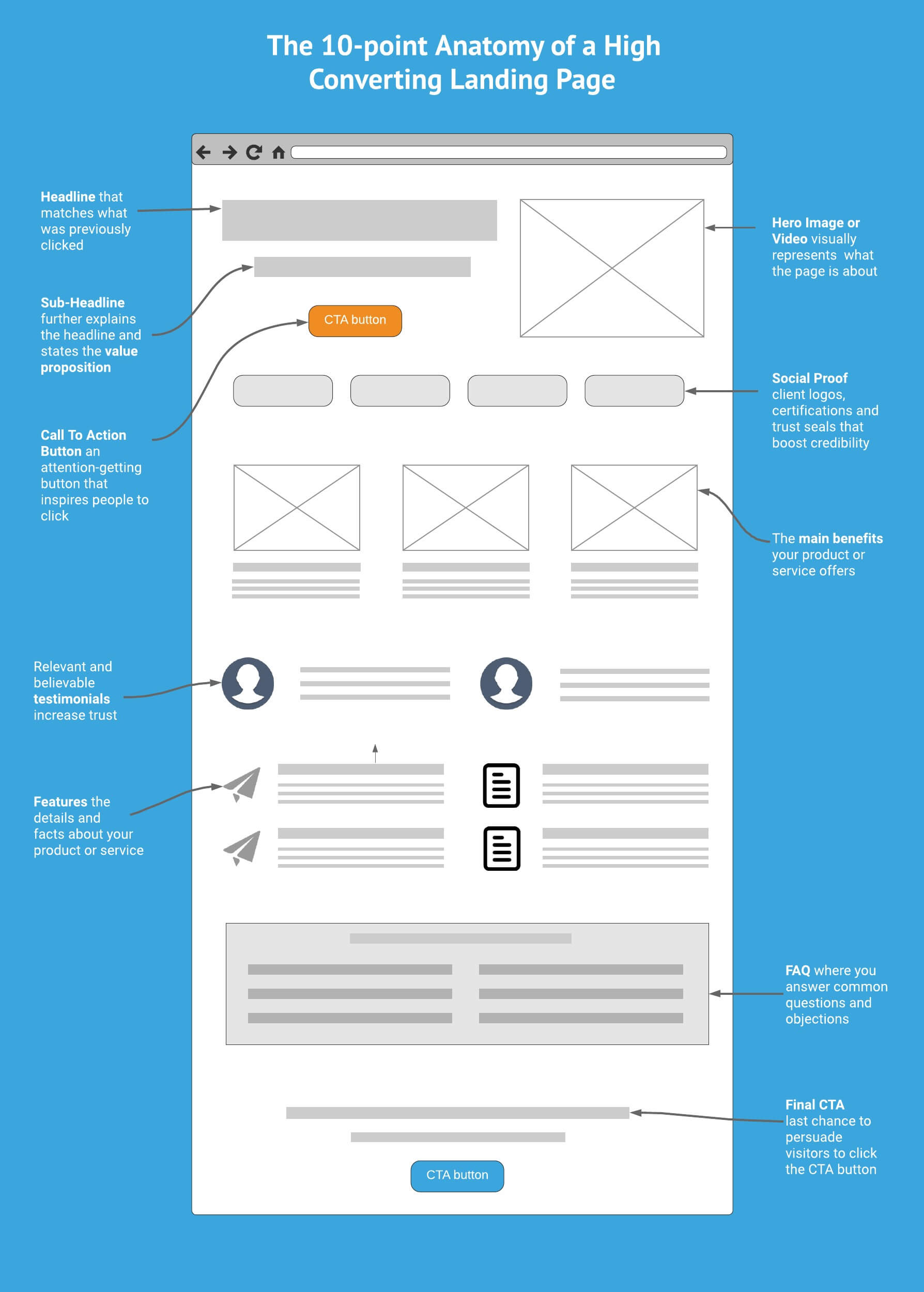
The Ultimate Guide to Website Copywriting for Beginners In 2022
Are you struggling to turn your visitors into customers?
Your website copywriting might be the reason.
These days, a consumer's average attention span is 8 seconds. It means that you have 8 seconds to grab your visitors’ attention, hook their interest, and convince them to stay on your website for longer.
Your website visitors will only read 20% of your web content.
That’s why you need carefully crafted website copy to ensure the words you choose resonate with your audience, enticing them to learn more and engage with your brand.
What You’ll Learn in This Guide
Wondering how website copywriting can drive customer engagement and increase your sales?
In this ‘’copywriting for websites’’ guide, I’ll answer two questions:
- What is website copywriting?
- Why is it so critical to any business?
I’ll also provide you with 10 website copywriting best practices to help you optimize your site and improve your bottom line.
What is Website Copywriting?

What is Website Copywriting?
Website copywriting refers to the process of writing words that inspire people to take action online. More specifically, it’s a form of content marketing that involves writing optimized content for web pages to achieve a specific goal, such as converting visitors into customers. Other goals or KPIs include capturing email addresses or driving organic traffic and qualified leads to your website.
A highly skilled web copywriter can craft compelling digital content for your various web pages, including:
- Landing pages
- Homepages
- About Us pages
- Product pages
- Contact pages
- Blog Posts
- Registration pages
- FAQ pages
- Case studies
- Press releases
Using professional website copywriting services will allow you to create high-converting online copy to increase leads, engagement, and sales.
Why Is Website Copywriting Important?

Writing high-quality website copy should be one of your main priorities as a business looking to grow.
Here are three main reasons why:
Improving your SEO
One of the main reasons you need to write compelling website copy is to help you rank higher in search engines and drive organic traffic to your website.
What is SEO?
Search engine optimization (SEO) is the process of optimizing your website with important elements like keywords to improve your search engine visibility. Using SEO best practices, such as selecting highly relevant keywords for your target audience, can help you drive qualified leads to your website and convert them into loyal customers.
The more high-quality content you write and add to your website, the better your search engine rankings will be. You'll then experience higher organic traffic and leads. For instance, small businesses featuring a blog experience 126% more lead growth than small businesses without a blog.
A talented website copywriter will be able to identify the best keywords for your web pages. They’ll then incorporate them seamlessly into the copy to optimize these pages for SEO and boost your visibility and traffic.

What is SEO?
Grabbing Your Target Audience’s Attention
You know what they say: ‘’you only get one chance to make a good first impression.’’ You also have approximately 8 seconds to grab your visitors’ attention and convince them to stick around.
The competition for consumers’ attention is fierce.
That’s why immediately hooking your leads and potential customers by sparking their interest is critical. Engaging website copy will allow you to craft compelling hooks that will capture their attention instantly, elicit emotions, and trigger engagement.
If you’re successful, your website visitors will want to:
Learn more about your brand and your products or services
Follow your social media pages
Sign up for your newsletter or special offer
Read and share your content
Comment in your comment section or discussion threads
Take any other action you would like them to take

Grabbing Your Target Audience’s Attention
Converting Your Visitors
If you’ve ever wondered why some websites tend to have much higher conversion rates than others, the answer is simple: they’ve mastered the art of website copywriting.
Writing high-quality content for your website is one of the most effective ways to stand out from your competition and turn browsers into buyers.
Mastering the website copywriting process can help you:
Convey your brand personality and humanize your company, leading your visitors to connect with you and buy your products or services.
Explain your product or service value proposition clearly so that your potential customers know exactly how your solution can improve their lives. They’ll then be prompted to buy your products or services.
Create powerful CTAs (calls-to-action) to encourage visitors to take action.
Craft attention-grabbing headlines to immediately spark your visitors’ interest (80% of website visitors only read headlines) and move them to action.

Converting Your Visitors
Website Landing Page Template
Adding a landing page to your website can boost your conversion rate by 23% on average. Here are ten tips on how to optimize your landing page for higher conversion and sales.

Website Landing Page Template
Web Copywriting Best Practices

Web Copywriting Best Practices
Now that we’ve defined what copywriting for websites entails and why it is crucial for your business, you might be wondering how to improve your website copy.
So, to help you nail the website copywriting process, we’ve highlighted below 10 website copywriting best practices.
1. Spend Time Crafting Your Meta Title & Meta Description
The meta description is an HTML tag that summarizes the content of a webpage. It’s the short snippet that appears underneath a specific page’s meta title and URL on Google search engine results page.
If well-optimized, it will allow your website content to come up in relevant search results when someone is running an online search.
Here are our best practices for writing a homepage meta title and meta description:
Your meta title should be around 7 to 10 words long (under 60 characters)
Your meta description should be between 20 and 30 words long
It should summarize what your product/service is about while inviting readers to click and learn more
Both should contain the primary keyword

Spend Time Crafting Your Meta Title & Meta Description
2. Write a Compelling Headline
The headline is the most crucial element to your website’s homepage because it’s the first thing visitors will read. If the headline is weak or confusing, visitors are likely to leave the page and exit your website.
Here are our best practices for writing a compelling homepage headline:
Clarity. The headline should be read and understood in about 5 seconds.
It should avoid hype (like ‘amazing miracle product’ or 'once-in-a-lifetime opportunity').
It states the benefits the visitor can expect clearly.
Avoid confusing jargon (like ‘value-added interactions’) unless you’re explaining technical details to a specialized audience.

Write a Compelling Headline
3. Include your Value Proposition in Your Sub-headline
The purpose of a sub-headline is to explain a headline further and encourage your visitors to stay engaged and to continue reading. But most importantly, your sub-headline should always convey your product or service value proposition and answer two questions:
Why should I choose you over your competition?
What benefits or results can I expect?
Providing a clear answer to these questions in your sub-headline will allow your ideal customers to instantly understand the value of your offer and how your solution can solve their problems.

Include your Value Proposition in Your Sub-headline
4. Call-to-Action
A CTA (aka call-to-action) button is a visually attractive,action-orientated button that lets your website visitors know what to do next, prompting them to take action. You should place your CTA buttons strategically on your pages so they’re easy to locate and identify. A well-placed and optimized CTA can significantly increase your conversion rate.
Here are our best practices for writing a click-worthy CTA button:
Compelling CTA button copy informs visitors what will happen or what they get if they click on the CTA button. Think action words.
Words like ‘submit’ or ‘register’ are too vague and are unlikely to inspire action.
The CTA button copy shouldn’t be more than four words long.
Here are some great CTA button copy examples:
Get Your Free Report Today
Request a Quote
Book A Meeting
Try It For Free
Get Started Now

Call-to-Action
5. Why Us?
The “Why choose us?” section should highlight your business’s competitive advantages and explain why your brand and products are so unique. It should also outline why your offer is superior to your competitor’s to convince visitors you have the best solution to their problems.
Here are our best practices for writing a ''Why Us'' section:
List some of your unique selling points, such as specific claims that your competition can’t use, and communicate them to your audience.
Be clear and detailed in your copy. You can even use a bulleted list to make things even clearer.
Include one well-researched keyword if possible and ensure it seamlessly blends with the copy and sounds natural.

Why Us?
6. Lead Magnet
A lead magnet is a helpful piece of content you can give away for free to website visitors in exchange for contact information. Brands generally use lead magnets as an incentive to generate leads and collect precious data about their existing and potential customers.
If you want your lead magnet to succeed, make sure it provides your ideal customers with valuable information to help them solve a problem or achieve a specific goal.
Lead magnets can come in different formats, including:
A video
A report
A spreadsheet
A webinar
A discovery call
A strategy session
A discount
Here are our best practices for writing an effective lead magnet section:
Write a headline and include the word ‘‘free’’
Explain what they will learn if they use your lead magnet
Write a strong CTA button copy that uses action words

Lead Magnet
7. About Us
Nowadays, consumers crave authenticity and genuinely want to connect with brands. They want to get to know the team behind the company, interact with real people and understand the brand’s story.
As a result, the best way to humanize your brand and provide that authenticity is through telling your brand story on your ''About Us'' Page. It’s an opportunity for you to make a great first impression on your potential customers.
Here are our best practices for writing the About Us section:
Showcase your fantastic team and highlight their expertise and experience.
Even though you’re writing about your company and your brand, remember always to circle back to how your offer can benefit visitors. Your ‘’About Us’’ page should communicate your brand story and present your offer in a compelling way to help visitors connect with you and encourage them to take action.
Include one well-researched keyword if possible and make it sound natural in the copy.

About Us
8. Products and Services
Depending on your website design, you might be listing all of your products or services on your homepage or have a dedicated product or service webpage. You might even have both, so visitors can see at a glance what your company offers when they land on your homepage.
A product or service page needs effective copy to help boost your visibility in search engines for related product or service queries and drive traffic to your website.
Here are our best practices for writing the product or services section:
Write a heading that captures your visitors’ attention.
Write a subheading that mentions the main benefits of your products or services.
Explain the function of each product or service and detail their benefits for your target audience.
Include at least one keyword if possible and make it sound natural.

Products and Services
9. Testimonials
Testimonials, such as customer feedback, are a highly effective way to develop social proof, increase your credibility and build trust with your customers.
However, not all customer testimonials are created equal. To turn your customer testimonials into a powerful marketing weapon, you’ll need to ensure they’re punchy, short, and concise, and come across as authentic.
The best testimonials typically include:
Specific achievements or benefits your offer has provided your customers.
The person’s full name, photo, and specifics about who they are to enhance their credibility when vouching for your products or services.
A clear and concise message

Testimonials
10. Trust Elements
Trust elements are images that instantly show visitors why they should trust your company as experts in your niche.
Here are some common trust elements you can use to establish your brand as an authority in your field:
Awards
Certifications
Associations
Recognizable clients
Media mentions
Here are our best practices for writing the trust elements section:
Write an attention-grabbing heading (e.g., ‘Trusted By Leading Companies’).
Write a subheading that briefly explains what the elements are.
Include names of the trust elements. For instance, don’t hesitate to mention the name of publications that feature your brand.

Trust Elements
Frequently Asked Questions About Website Copywriting

Frequently Asked Questions About Website Copywriting
Question: How much does website copywriting cost?
Answer: At Copywriting Crew, we pride ourselves on offering affordable website copywriting services. Our prices start from $195 for website copy. Don’t hesitate to browse our copywriting pricing page to see our different services and fees.
Question: Can I see some copywriting examples?
Answer: We’re busy bees and work with many clients across various industries. So, feel free to peruse our numerous website copywriting portfolio examples. You'll find examples organized by type of content and industry.
Want to Take Your Website Copy to the Next Level?
We hope this blog post has shed some light on how critical online content and website copy are to your success as a business owner. Follow our ten best practices, and you should be on your way to increasing your engagement and sales.
Don’t have the time, resources or online copywriting skills to write an engaging and optimized website copy?
One of our highly experienced professional copywriters can help! Based on your brief and needs, we’ll assign a dedicated industry expert as well as an editor to your project. They'll harness persuasive writing techniques to turn your brief into high-quality online content that converts, and offer a short delivery time.
At Copywriting Crew, we can assist you with anything from web copy to social media posts and blog posts and we always strive to exceed our customer expectations.
If you would like to use our website copywriting services, get in touch with our founder for a free 15 min discovery call to discuss your needs. Alternatively, you can place an order directly on the order page to get started.
Further reading
To help you get your creative juices flowing, here are two blog posts that should provide some inspiration:
